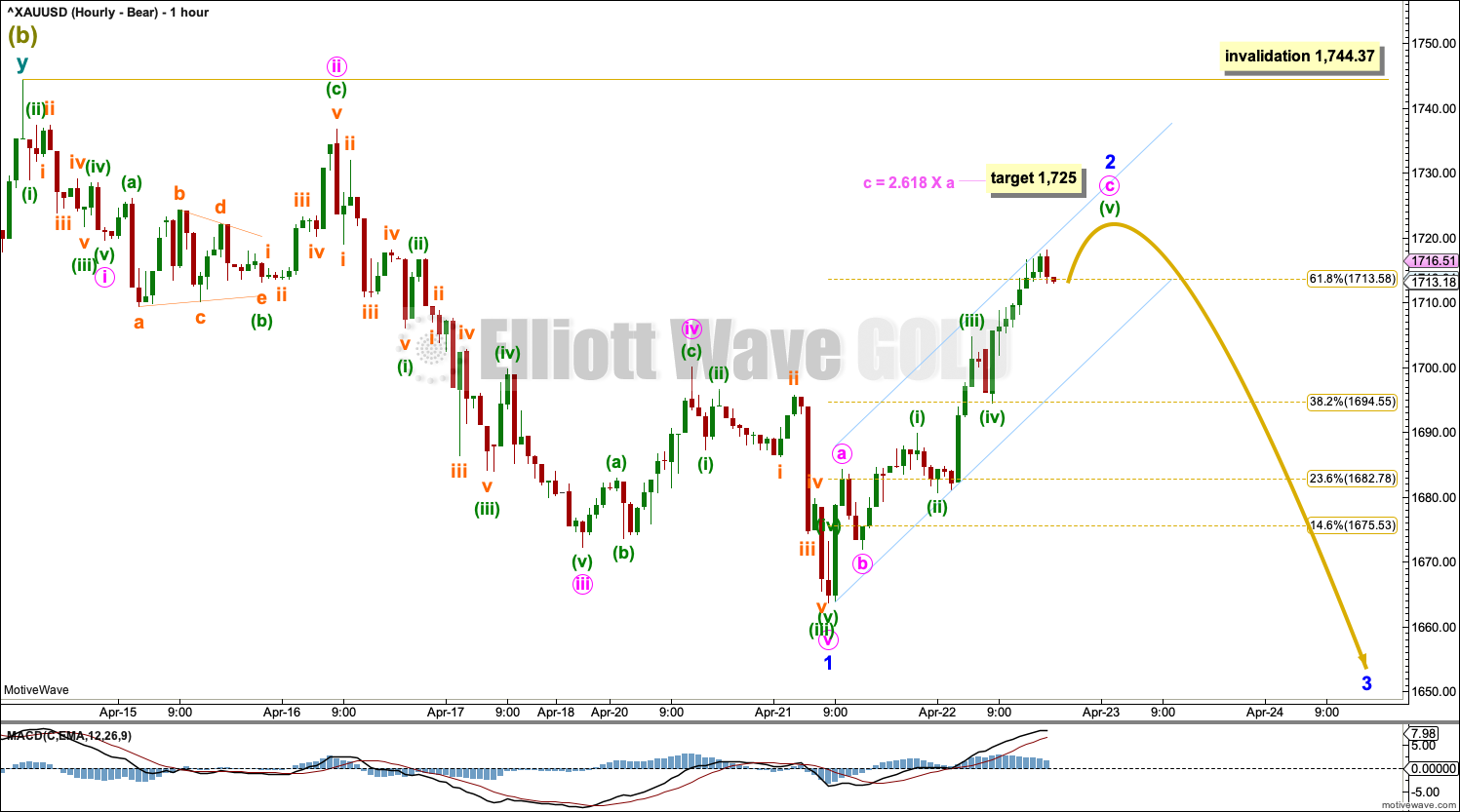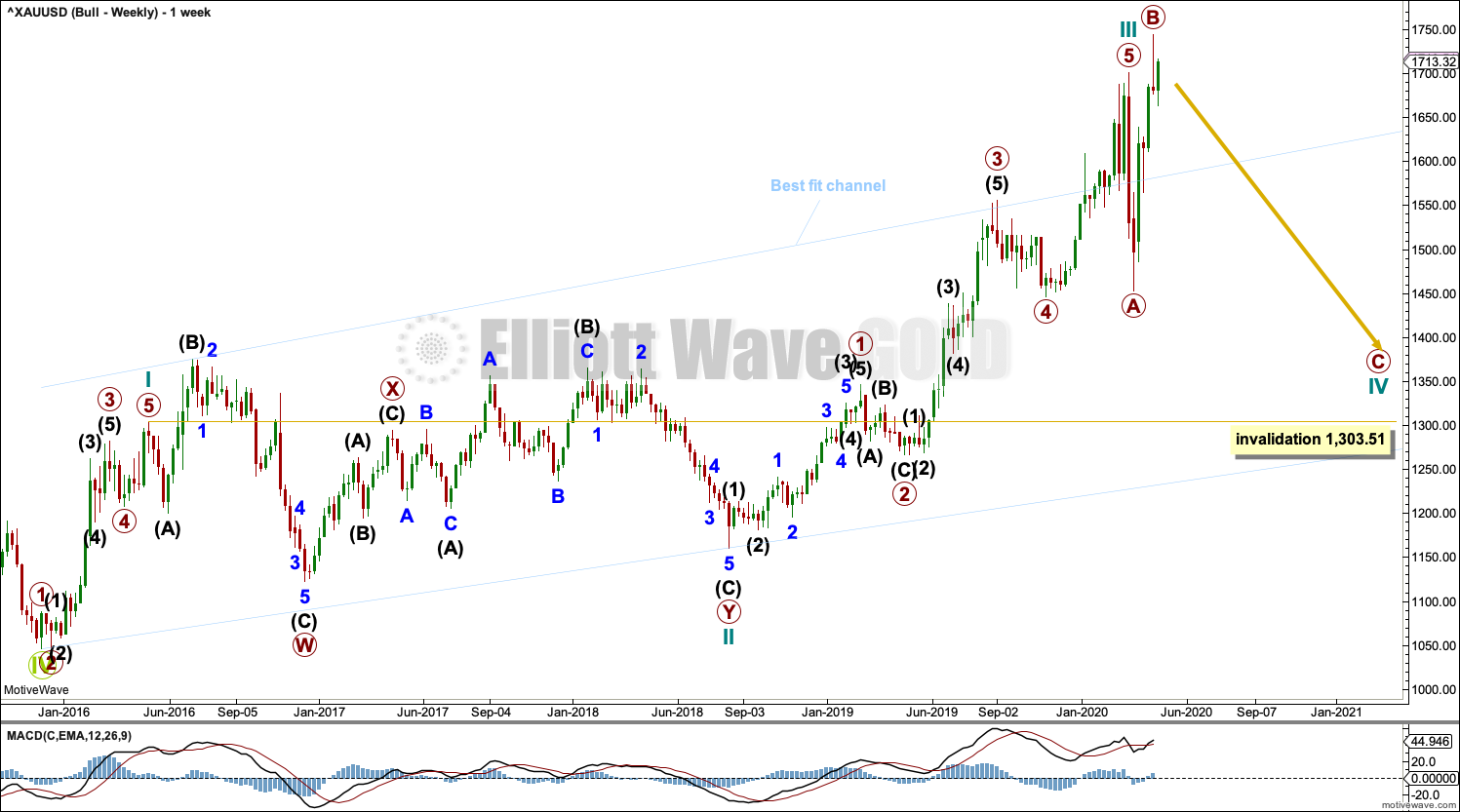GOLD: Elliott Wave and Technical Analysis | Charts – April 22, 2020
For the short term, a bounce was expected to reach above 1,714 or above and to last one to a few days. This last session has seen price move higher to reach up to 1,718.20.
Summary: A high may now be in place. A target for the bullish wave count for a downwards wave is at 1,324. The main bearish wave count expects a new downwards trend for several months to new lows below 1,046.27.
For the short term, a bounce may end tomorrow about 1,725. When the narrow channel on hourly charts is breached by downwards movement, then that may be earliest indication that the bounce could be over.
Grand SuperCycle analysis is here.
Monthly charts were last updated here.
MAIN BEARISH ELLIOTT WAVE COUNT
WEEKLY CHART
Super Cycle wave (b) may be a complete double zigzag.
The first zigzag in the double is labelled cycle wave w. The double is joined by a three in the opposite direction, a combination labelled cycle wave x. The second zigzag in the double is labelled cycle wave y.
With cycle wave x ending earlier and cycle wave y beginning earlier, primary wave A within cycle wave y now looks like a five wave impulse. Primary wave B may be a complete expanded flat correction. Primary wave C may be a complete impulse.
The purpose of the second zigzag in a double is to deepen the correction. Cycle wave y has achieved this purpose.
A wide best fit channel is added in light blue. Copy this channel over to daily charts.
DAILY CHART
The daily chart focusses on the structure of cycle wave y. It is possible again that primary wave C may be over. Technical analysis of StockCharts data supports a possible trend change.
A new low below 1,666.41 would add confidence that a high is in place. While price remains within the narrow channel and above this price point, then it is possible that the upwards trend remains.
HOURLY CHART
Minor wave 1 may be complete.
Minor wave 2 may be close to completion as a deep zigzag. A target is calculated for minor wave 2 to end.
Draw a best fit channel about minor wave 2 to contain all upwards movement. If this channel is breached by downwards (not sideways) movement, then that may be taken as earliest indication that the bounce may be over and a third wave down may have just begun.
Minor wave 2 may not move beyond the start of minor wave 1 above 1,744.37.
ALTERNATE BULLISH ELLIOTT WAVE COUNT
WEEKLY CHART
This wave count sees the the bear market complete at the last major low for Gold on 3 December 2015.
If Gold is in a new bull market, then it should begin with a five wave structure upwards on the weekly chart.
Cycle wave I fits as a five wave impulse with reasonably proportionate corrections for primary waves 2 and 4. This resolves a previous major problem with the bullish wave count.
Cycle wave II now fits as a double flat. However, a problem arises with the relabelling of this structure. Within the first flat correction labelled primary wave W, this wave count now needs to ignore what looks like an obvious triangle from July to September 2016 (this can be seen labelled as a triangle on the bear wave count above). This movement must now be labelled as a series of overlapping first and second waves.
Within the first flat correction labelled primary wave W of the double flat of cycle wave II, intermediate wave (B) is 1.69 the length of intermediate wave (A). This is longer than the common range of up to 1.38, but within an allowable guideline of up to 2. The length of intermediate wave (B) reduces the probability of this wave count.
Cycle wave III may be complete. Cycle wave IV may not move into cycle wave I price territory below 1,303.51.
DAILY CHART
Cycle wave III may be complete. Cycle wave IV may not move into cycle wave I price territory below 1,303.51.
Cycle wave II was relatively deep at 0.55 of cycle wave I. If cycle wave IV exhibits alternation in depth, it may more likely be shallow; the first target at 0.382 of cycle wave III would be preferred.
Cycle wave IV may subdivide as a flat correction, triangle or combination. Both a flat and triangle would still provide structural alternation with the combination of cycle wave II.
If cycle wave IV subdivides as a flat correction, then within it the common range for primary wave B within a flat would be from 1 to 1.38 times the length of primary wave A. If primary wave B is now over, then it is within this most common range.
If cycle wave IV subdivides as a triangle, then within it primary wave B may make a new high above the start of primary wave A as in a running triangle.
Primary wave B may be a complete zigzag.
There is no upper invalidation point for this wave count.
HOURLY CHART
Minor wave 1 may be complete. Minor wave 2 may not move beyond the start of minor wave 1 above 1,744.37.
ALTERNATE BEARISH WAVE COUNT
DAILY CHART
This wave count follows the alternate monthly bearish wave count published in last monthly analysis, which is linked to each day at the beginning of this analysis.
This wave count looks at the possibility that Grand Super Cycle wave (II) may be a flat correction, which would require Super Cycle wave (b) within it to retrace a minimum 0.9 length of Super Cycle wave (a) at 1,832.79. Super Cycle wave (b) may make a new high above the start of Super Cycle wave (a) at 1,920.18 as in an expanded flat.
By moving the degree of labelling within primary wave C down one degree, it is possible to see that it may be incomplete. Only intermediate wave (1) within primary wave C may be complete. Intermediate wave (2) may not move beyond the start of intermediate wave (1) below 1,453.26.
This wave count should only be used if price makes a new short-term high above 1,744.37. At that stage, it would increase in probability.
TECHNICAL ANALYSIS
WEEKLY CHART

Click chart to enlarge. Chart courtesy of StockCharts.com.
A long upper wick, a close near lows for the week, and a slight increase in volume for this last downwards week compared to the prior upwards week all suggest more downwards movement this week.
DAILY CHART

Click chart to enlarge. Chart courtesy of StockCharts.com.
An Advance Block pattern, a long upper wick, and now an Evening Star pattern are all bearish reversal signs. Mid-term bearish divergence between price and RSI increases the bearishness of these signals.
The short-term volume profile remans bearish. A bounce may be over here or very soon.
If upwards movement continues and volume supports it, then this analysis may favour a more bullish outlook. But with data in hand today, it does not.
GDX WEEKLY CHART

Click chart to enlarge. Chart courtesy of StockCharts.com.
Weak volume for upwards movement and now a bearish long upper wick suggest more downwards movement this week.
GDX DAILY CHART

Click chart to enlarge. Chart courtesy of StockCharts.com.
Today has effected an upwards breakout from a small pennant pattern. The breakout has support from volume and is accompanied by a breakaway gap. As breakaway gaps should not be closed (prior to the target or about that point), they may be used as support. Look for support here at 30.87.
A target from the pattern is calculated at 37.44.
Published @ 06:45 p.m. EST.
—
Careful risk management protects your trading account(s).
Follow my two Golden Rules:
1. Always trade with stops.
2. Risk only 1-5% of equity on any one trade.
—
New updates to this analysis are in bold.







